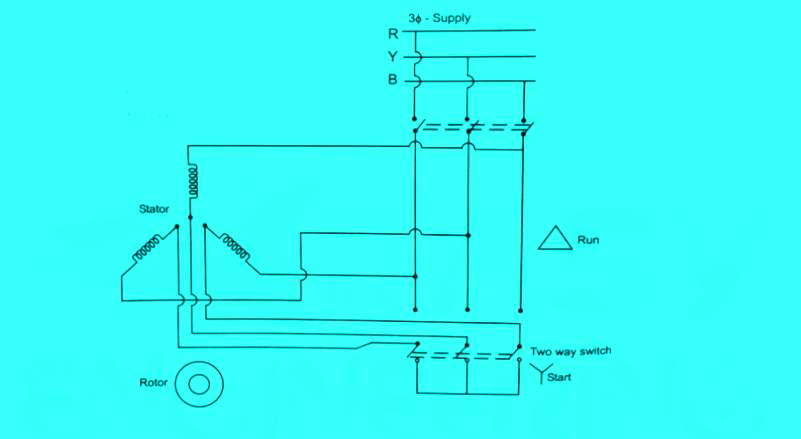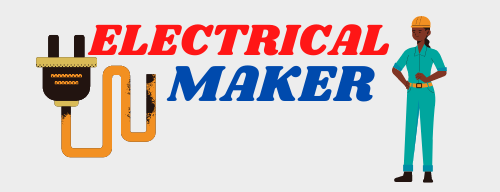What is a Star to Delta starter?
Star to Delta starter or star-delta starter is one of the most common methods used for starting of three-phase induction motor. When the stator winding of the motor is directly connected with the supply, it will draw a very high current, and to control this high current Star-Delta starter is used
A star to delta starter or star-delta is used for a squirrel cage motor designed to run normally on delta-connected stator winding. This star is used with the squirrel cage induction motor having a capacity of up to 5 hp.
In starting position, the downward of the stator winding is connected in star connection. Then the voltage of each winding will be equal to √3 times the line voltage i.e 57.7% of the line voltage.
When the rotor gains speed then the starter quickly changed to run position means in the upward direction thereby connecting the stator winding in delta connection.
In the delta connection phase voltage becomes equal to the line voltage then full line voltage is applied to the stator winding and the motor will run at its normal speed.
Explanation of star delta starter
In most cases, induction motors are started directly on line voltage but when very large motors are started in that way then these motors cause a disturbance to the supply voltage line due to the large starting current.
To limit this high starting current, a large induction motor is started at reduced voltage and then full supply voltage is reconnected when the motor run-up to near rotating speed.
Generally for the reduction of starting voltage two methods are used i.e star-delta starting and Autotransformer starting. The above method is the reduced voltage starting method.
Voltage reduction during star-delta is achieved by reconnecting the winding physically as shown in the figure.

At the starting of the induction motor, the windings are connected in star connection and due to this connection, the voltage across each winding is reduced. This will also reduce the torque by a factor of three.
After a period of time, the windings are reconfigured as delta and the motor will run to its normal speed.
Star delta starter is usually the most common type of reduced voltage starters. This is used to reduce the starting current applied to the motor during starting as a process of reducing the disturbance and interference on the electrical supply.
In many areas, there is a need for a reduced voltage starter for all the motors greater than 5hp. Then this star-delta starter is one of the economical voltage starters that can be used.
Theory of star-delta starting
During start: the stator winding is connected in star and therefore the voltage across each phase winding is equal to 1/√3 times the line voltage.
If,
VL=line voltage to the motor.
Zph =impedance of the stator per phase.
Vph=VL/√3
Iph=Vph/Zph = VL/√3Zph
Here motor is connected in star so, the line current is equal to the phase current
ILY=Iph
Where,
ILY= Line current in star connection.
Iph= phase current of the motor.
ILY=VL/√3Zph
At the running of motor, the motor is connected in delta connection then,
VL=Vph
and, Iph=Vph/Zph=VL/Zph
ILD=√3Iph
Where ILD= line current in delta connection.
ILD=√3Iph
=√3VL/Zph
ILY/ILD= VL/√3Zph/√3VL/Zph= VL/√3Zph × Zph/√3VL =1/3
ILY=1/3 ILD
Torque during starting condition,
Tst=I2LYr2/s
Where, ILY=Iph=Ist and, slip(s) =1
Advantages of star delta starter
- Running of star delta starter is easy and rugged
- In comparison to other reduced voltage methods, a star to delta starter is relatively less costly.
- Good torque per ampere performance.
- Efficiency increases as no heat are produced due to tap changing device is used.
Disadvantages of star delta starter
- Starting torque is low.
- There is a break possible in supply.
- Requirement of six terminal motors.
- It requires two sets of cables from starter to motor.
- Only 33%starting torque is provided by the motor and if the load connected to the subject motor requires higher starting torque at the time of starting then very heavy transients and stress are produced while changing from star to delta connections, and because of these transients and stress many electrical and mechanical breakdown occurs.
